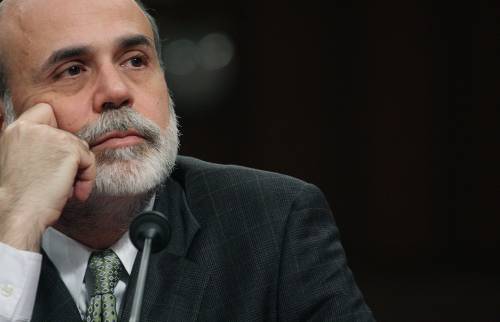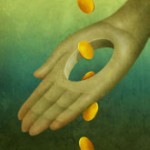Fed’s $1.6 Trillon Bet
Federal Reserve Chairman Ben Bernanke spent his academic career studying the Great Depression. But this economic meltdown is uncharted territory. It turns out the Fed already guaranteed $650 billion even before Congress ok’d that $700-billion bailout.
Jul 31, 20201.8K Shares59.1K Views
Federal Reserve Chairman Ben Bernanke (WDCpix)
Amid the clamor over the crisis on Wall Street, the U.S. Treasury’s $700 billion Troubled Asset Rescue Program, or “TARP,” bill and the evolving collapse of the global banking system, little attention has been paid to the extraordinary credit extensions at the Federal Reserve. But these are now without parallel in Fed history, including during the Great Depression.
In the last three weeks, Federal Reserve Chairman Ben S. Bernanke, with the help of Treasury Sec. Henry Paulson Jr., has increased the Fed’s credit extensions by $650 billion — roughly the same amount as the TARP. Taken together with the Fannie Mae/Freddie Mac bailouts, new Fed credits in just the last month or so now amount to some $1.6 trillion. Here’s how they did it.
Illustration by: Matt Mahurin
The Fed, to begin with, is a bank. Like other banks, it makes loans and investments, which are its “assets.” It finances them by taking deposits, mostly from its member banks, and raising capital, its “liabilities.” In the normal case, almost all its assets are loans to the government, or Treasury bills, notes and bonds; while its primary liabilities are its own debt certificates.
You’ve seen the Fed’s debt certificates; they’re green and carry the legend “Federal Reserve Note.” In other words, money. The Fed’s role in the economy is to stabilize the money supply so it is neither too plentiful, which can generate inflation, nor too scarce. It does so largely by manipulating the rate of interest that banks charge each other for overnight loans, the “Fed Funds” rate. If the Fed issues more currency to buy Treasuries from its member banks, banks become more liquid and the Fed Funds rate should fall; and vice-versa.
Bernanke is a serious academic who devoted much of his career to extensive studies of the failure of central banks during the Great Depression. He is the lead author of a 2004 Federal Reserve working paper, exploring the Fed’s policy alternatives “At the Zero Bound” — or the point where the usual tools of interest-rate policy cease to have any effect on the real economy.
In the paper, Bernanke poses a common policy conundrum. It sometimes happens that pushing down Fed Funds rates has no effect on medium- or long-term rates — or can even make them rise, if markets are worried that too much liquidity could cause inflation.
In such a case, Bernanke suggests, the Fed could use its balance sheet in a more targeted way. “If the Federal Reserve were willing to purchase an unlimited amount of a particular asset, say, a Treasury security, at a fixed price,” Bernanke wrote, “there is little doubt that it could establish that asset’s price.” But the Princeton economics professor also warned that the Fed should be “cautious” about such a strategy, since its results could be “quite uncertain.”
Starting in late 2007, and continuing ever more aggressively through 2008, Bernanke, as chairman, started precisely such an experiment in using the Fed’s purchasing power to target asset prices. But instead of targeting specific maturities of Treasuries, he targeted the illiquid assets weighing down bank balance sheets. In effect, could the Fed establish the price of the complex subprime mortgage-backed debt instruments, known as “CDOs’:and similar paper that has been destroying bank balance sheets?
The first attempt, in December, 2007, was appropriately cautious — it was relatively small and short-term; open only to Federal Reserve system member banks, and circumspect on acceptable securities. But step-by-step, he expanded the eligible borrowers from member banks to broker-dealers, then to AIG, an insurance company, and, most recently, directly to major corporations, mostly on an unsecured basis. At the same time, Bernanke greatly increased the volume and the range of targeted securities he would lend against, to include “investment-grade” (translation: “anything not junk”) CDOs.
The Fed’s weekly balance sheet has evolved into a fever-chart of Bernanke’s interventions. Start with the balance sheet of a year ago, in October, 2007. Total Fed assets were $890 billion, of which $780 billion comprised Treasuries, with the balance scattered among gold certificates, physical plant and other miscellany — or roughly the size it had been for several years.
Now jump ahead to the balance sheetfrom last week. The Fed’s assets have swelled to $1.6 trillion, an increase of 80 percent. But only $265 billion are Treasuries actually held at the Fed. The rest are a mélange of god-knows-what instruments vacuumed up from banks and investment banks.
There are $149 billion in dicey securities exchanged for Treasuries in bi-weekly auctions; “Other Loans,” to the tune of $420 billion (all we know is that it includes the credit extension to AIG, which has climbed to about $100 billion); a special $29-billion line for Bear Stearns, and $145 billion in direct lending to companies. There is also $325 billion in “Other Assets” — probably mostly dollars for foreign central banks to help local banks choking on dollar-based CDOs and other poison apples from America.
The total lending expansion, therefore, was about $700 billion, with about $650 billion in just three weeks since Paulson and Bernanke proposed what became TARP to purchase banks’ bad assets, or otherwise provide them with new equity.
In other words, even as academics and Congress agonized over TARP, Bernanke and Paulson had already pumped out roughly that amount of money — without so much as asking for a by-your-leave. Paulson even engineered a special $400-billion Treasury borrowing program -– i.e., increased the federal debt — to supply part of the extra cash needed to support Bernanke’s lending.
Fascinatingly, Bernanke’s fire-hose of liquidity has so far been accompanied by a steady tighteningof lending conditions. Some market watchers worry that interbank liquidity is drying up because borrowing at the Fed is so much easier. Only time will tell.
If there’s one lesson from the past few years, it is the formidable nature of the law of unintended consequences. The vast new infusions of dollars will weigh on U.S. international balances for years. It is all in the name of staving off a “recession,” which now looks something like the 1960s specter of nuclear Armageddon.
We may have reached the point where the cure is scarier than the disease.
Charles R. Morris, a lawyer and former banker, is the author of “The Trillion Dollar Meltdown: Easy Money, High Rollers and the Great Credit Crash.” His other books include “The Tycoons: How Andrew Carnegie, John D. Rockefeller, Jay Gould and J.P. Morgan Invented the American Supereconomy” and “Money, Greed, and Risk: Why Financial Crises and Crashes Happen.”

Paula M. Graham
Reviewer
Latest Articles
Popular Articles

